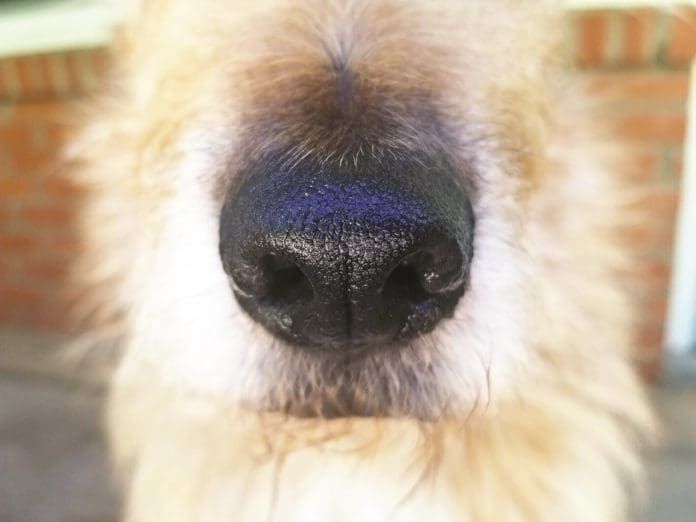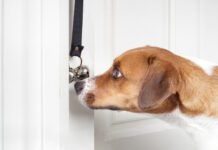
All dogs have noses – and they all know how to use them. Our awareness of our dog’s nose capabilities is nothing new. We humans have long taken advantage of our dogs’ scenting prowess in a variety of ways – hounds who track game, rescue dogs who search for missing persons, narcotics detection dogs who find hidden drugs, and much more. Recently, however, both science and the dog-training world have taken a new look at and developed a new respect for the dog’s olfactory abilities, and what putting them to use can do for your dog’s mental and behavioral health!
Know this about Dog Noses
First, some basic biology. According to Alexandra Horowitz, Ph.D., psychology professor and head of Barnard College’s Horowitz Dog Cognition Lab at Columbia University in New York, while humans have about 5 million olfactory cells, dogs have between 200 million and 1 billion. Did you get that? Between 200 million and 1 billion. So even the dogs at the low end of that range have 1,000 times as many olfactory cells as we humans!
Dogs also have a “second nose” – the vomeronasal organ (also called Jacobson’s organ), which enhances the dog’s ability to detect and identify scent. These two factors combined help to explain why our dog’s sense of smell is so much better than our own.
Nosing Around
Today, dog noses are employed in a long list of activities that go far beyond hunting for game. The list is ever expanding, and we are just beginning to recognize the benefits the dogs themselves reap from being allowed and encouraged to use their super-noses.
The rapidly growing popularity of K9 Nose Work competition and titling has brought revelations to the dog-training world about the behavioral advantages of encouraging dogs to use their noses. A growing number of shelters and rescue groups are also realizing the benefits of allowing/encouraging their canine charges to engage in scenting activities to make their dogs more adoptable. Many previously fearful dogs have come out of their shells and gained confidence in leaps and bounds as a result of doing scent work – perhaps because it is so innately reinforcing to them, and they are so capable of success.
Most humans recognize how immensely success contributes to our self-confidence. The same is true of dogs (and other species). Even something as simple as the “Find it!” game (described on the next page) can do wonders to help a shy or fearful dog adjust to the scary world. If you are interested in enrolling your dog in K9 Nose Work classes and/or competition there are certified trainers all over the country who can help you; see “Sniff Out These Resources,” above.
Scent and Cognition
Horowitz has been exploring the connection between a dog’s sense of smell and his cognition. A “sense of self” or self-recognition is one of the elements of cognition, and the long-held test for self-recognition has been an animal’s ability to recognize himself in a mirror. The way this is usually tested is to put a dot of colored paint on the face of the subject and hold up a mirror. If the subject touches the dot on his own forehead, the conclusion is that he realizes it’s him in the mirror – he has a sense of self. If he touches the dot on the reflection instead, he supposedly does not recognize himself.
As of 2015, only great apes (including humans), a single Asiatic elephant, dolphins, orcas, and the Eurasian magpie had passed this test. A wide range of species have reportedly failed the test, including several species of monkey, giant pandas, sea lions, and dogs.
Recognizing that dogs may have a stronger self-recognition through scent rather than sight, Horowitz devised a study to test this, by allowing them to smell the scent of their own urine and another dog’s urine. The results of her study seem to confirm her hypothesis. Her subject dogs spent more time sniffing another dog’s pee than their own, indicating a self-association with their own scent, hence a sense of self.
Scent as a Reinforcer: “Premack” It!
Switching from science back to practical (with a touch of science) if you are frustrated by your dog’s constant sniffing on walks, here are a couple of things to consider:
- As humans we really rely on our sense of vision. Imagine if you were walking along a path with gorgeous vistas, beautiful scenery, and amazing wildlife, and your guide kept grabbing your hand and dragging you along every time you wanted to stop, take in the view, and maybe take some pictures. That’s how your dog feels.
- When you take your dog for a walk, who is the walk for, anyway? If it’s so she has an enjoyable experience, consider her preferences, and let her stop and sniff!
- You can use the Premack Principle to teach your dog to walk more willingly with you even when there are tempting scents present.
To employ the Premack Principle, you use a more likely/more desirable behavior as the reinforcer for a less likely/less desirable behavior. (Some people call this “Grandma’s Law”: You have to eat your vegetables before you can eat your dessert.)
You can click-and-treat your dog for walking nicely with you, but if you occasionally tell her to “Go sniff!” as the reinforcer for polite walking, you’ll score big points in her eyes. Do it frequently and you’ll likely end up with a much more willing walking partner who trots happily next to you in eager anticipation of the next “Go sniff!” cue.
The Bond
There is one more incredibly important benefit of encouraging your dog to use her nose: Your presence during her highly reinforcing, very enjoyable scent activities will enhance your relationship with her, and strengthen the bond that you already have. What’s not to like about that?
So, consider the various options for playing with your dog’s nose, from the very simple “Find It!” to finding lost pets and humans, and everything in-between, decide what you want to do, and start getting nosey. Your dog will love you for it!
To learn to play “Nose Games” with your dog, read How to Teach Your Dog to Play “Nose Games”.






this is great information! thank you!
Whole Dog Journal, I have 1-word; OMG! Scott Baggett has no degrees, he makes no claim to be an expert in Dog Behavior. However, Scott has been training all types of working dogs and a lot of therapy Dogs. Scott has been telling anyone who would listen for years. If I could teach Handlers to understand “their dogs Olfactory”!! That might be the most important part of any Dog. I noticed years ago after training hounds for hunting, then came my German Shepherds, and then came my Golden Retrievers. I noticed that every breed, every dog within each breed has a different Olfactory.
Interesting, that everybody is finally catching up to what Scott had known for years.
My pup Mea was sniffing a little spot on the back of my arm.
It HAD been itching, but it didn’t register as anything I should worry about.
About 2 months later during my yearly dermatologist inspection, it turned out to be squamous cell carcinoma!
I LOVE THAT DOG!!!
Very interesting but please check your math on the 1000 times. It should be 40 times up to 200 times.
I love to set up ‘treasure hunts’ in the back yard for my two – it’s great to see them catching the scent on the breeze and working out where the treat is. I use tiny training treats from Bonza Dog Treats so they can have a long sniffing session without having to worry about the calories
My dog, a Boston Terrier/ Miniature Pinscher cross is almost 16 yrs old and has cataracts and diminished hearing in one ear. I need to know if as dogs age, their sense of smell also diminishes.
As far as I know, the sense of smell remains the same. We had a dog who was blind and deaf towards the end of his life (he lived until 18 years and 8 months) but was still very happy, enjoyed playing, eating and walking (obviously, in a safe settingJ.
Wow this was really cool and would’ve never guessed that dogs have two noses.